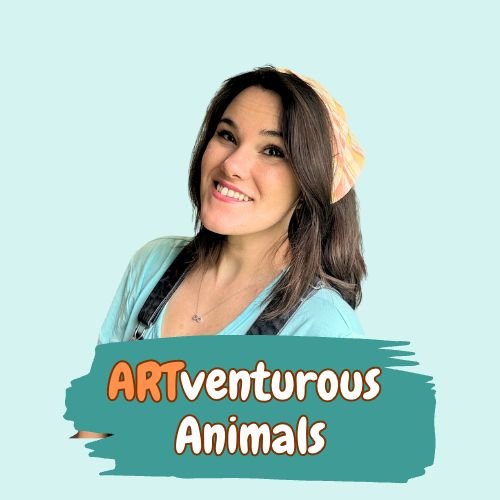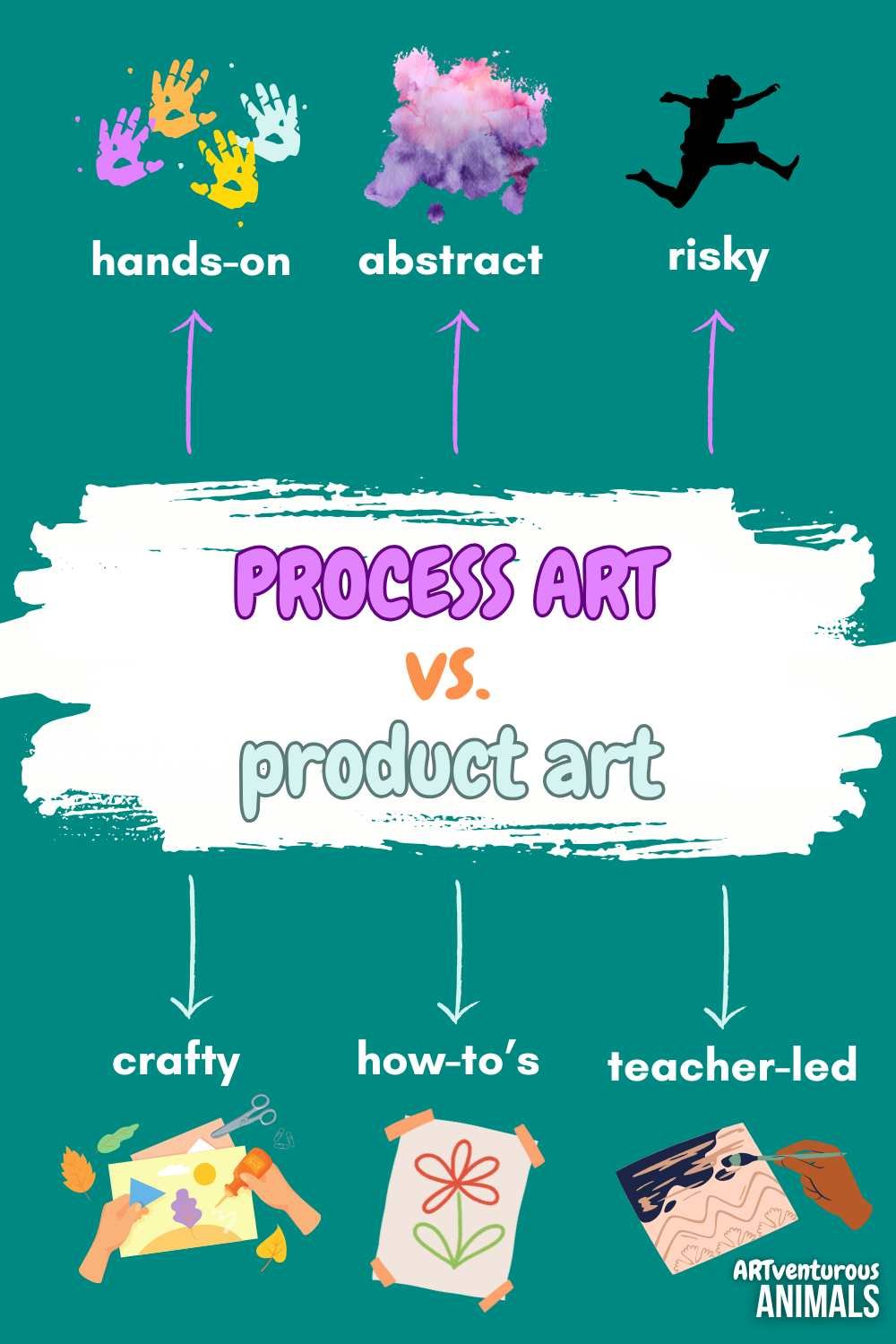Let them be MESSY: Process vs. Product Art
Are we messing up our kids by only teaching them crafts and calling it art?
There’s recently been a movement for allowing kids to be messy in art. This movement claims that process art is better for children developmentally. In fact, there are some advocates for process art who concluded that product art (more on this later) is harmful for kids.
So is all this true? Are you messing up your kids by NOT letting them be messy? Let’s dive into the world of process art vs. product art and find out.
I’m an online art teacher, but my conclusion might surprise you.
Share on Pinterest!
There are 2 types of travelers: those who hustle to see all the sights (like the colosseum) and those who sip their coffee in a cafe outside the colosseum.
My husband is the hustler and I’m the coffee-sipper. He’s all about the destination, while I’m here for the journey.
Our combination has led to us finding a balance of hustling to the destination so we can sit and enjoy it. And I love it!
Process art vs product art is a lot like that. Product art is the hustle to the destination, while process art is the coffee-sipping. Process art enjoys the journey.
Receipts 👆
What is process art and product art?
Great question!
“...art that focuses on the experience and process involved in creating. It is free, open-ended art, meaning children are able to freely choose what materials to use, how to use them and what to create.” —Empowered Parent
On the flip side:
Product art puts…
the value…in the final result rather than in the experience of producing it. —Gift of Curiosity
Product art:
-is crafty
-teaches how to follow directions
-encourages the child to admire the completed project
-instills a sense of accomplishment
-is finished art
-teaches specific skills
-includes how-to-draw tutorials
-directly teaches the elements of art
Process art:
-includes abstract art
-encourages experimentation
-relies on the child taking calculated risks
-teaches individual expression
-is play!
Both are good. You need both. Wait, I’m getting ahead of myself…
So which is better?
Process art is gaining traction in the art education realm. Why wouldn’t you want to allow your kids to explore and play through art? It sounds like the perfect way to teach art.
Here’s the tea:
Process art began around the 1960s. It was pioneered by none other than Jackson Pollock and his iconic drip paintings. He would interact with the canvas in such a way that the art wasn’t just what ended up on it. The art was also him. He enjoyed the process of creating and experimenting so much, that a new generation of artists came into being. They started playing around with wax, tar, fabric, and various other materials that were seen as unglamorous and not artistic.
Fast-forward to today. Educational specialists have seen the benefits of process art for young children. Many art educators have been incorporating process art into their classrooms and—anecdotally—have gotten great results.
There’s push back though.
Here are some common questions:
🎨 Why does process art have to be so messy?
🎨 Why can’t kids learn to keep the paint on the paper or color inside the lines?
🎨 How will kids learn how to draw or the elements of art?
🎨 Does that mean we should get rid of product art?
Let’s address each question:
Why does process art have to be so messy?
Process art allows kids to explore without risks. That does mean, however, that they will make messes. That’s part of it!
“Nothing will stop you being creative more effectively as the fear of making a mistake.”
Why can’t kids learn to keep the paint on the paper or color inside the lines?
The simple answer is they can. Kids are able to follow instructions, copy pictures, and learn to use the elements of art.
But they miss out on multiple benefits if that’s the only type of art they do.
If they only color within the lines, they won’t ever learn to make their own.
How will kids learn how to draw or the elements of art?
This is why I personally believe that product art has a place in a child’s art education.
When a child is young and still developing fine motor skills, process art should be the focus. They get to experiment with textures, colors, and mediums in a risk-free, stress-free way.
As they grow into elementary-aged children, product art should be mixed into the process as they show interest.
Are they asking how to draw a penguin? Show them how.
Are they curious about watercolor? Teach them how.
Are they interested in the elements of art? Let them take a class.
There should never be pressure or stress put on kids when they move into formal art skills. However, that doesn’t mean they can’t learn formally! Go at your child’s pace and interest level. Follow your intuition.
Does that mean we should get rid of product art?
No! Absolutely not.
I’m going to give my strongest argument for product art:
JACKSON POLLOCK LEARNED HOW TO MAKE ART FROM PRODUCT ART.
Every great artist had to start with the basics: drawing, coloring, sketching, painting, color theory, art elements, etc.
After they had those mastered, learning from the greats before them, they could move on and expand into new forms of art (like process art!).
Although we want to empower our children to think for themselves, this does not automatically negate the need to learn from those who have gone before us.
I think process art is valuable.
I think process art is necessary for kids.
But without the core techniques, skills, and information, kids can feel stuck. As they get older, they can end up feeling like they can't express themselves.
Learning to draw for example can help kids unlock that form of expression the way learning to write can.
Art that Combines Process and Product
I believe the best way to interpret these facts and opinions is to combine process and product art.
Process art provides the creativity and autonomy that we love to see, but product art teaches basic art skills that future artists need to develop in order to continue their art journey into adulthood.
Here’s a way we flesh this out:
Product art says:
“Let’s make a dinosaur!”
Process art says:
“Let’s finger paint!”
Combo:
“Here are some finger paints. Here’s a paper dinosaur. What would you like to do?”
This is an example from an art project I did with my son.
I printed out a raptor that I had drawn and asked him where on the cardboard he wanted him to go. My son smashed him down on the left side. Then he picked out paint and started covering him up. I helped him paint the whole piece of cardboard and we let it dry.
Next, we went outside and grabbed some leaves. My son picked out 3 of different sizes and placed them on the dried cardboard. Then he picked out a new paint color and paint on top. I helped him cover up the leaves.
Once that was dry, we peeled back the leaves and raptor and got this amazing silhouette art!
This is a great example of process and product art being used simultaneously.
Watch the full tutorial so you can try it yourself!
Messy Art Conclusion
So here it is: process art and product art are both necessary to true creativity.
Process art seems to be most helpful to children are younger, although there is a place for it all throughout our life. I, even as an adult, still do process art myself just for fun! But it is best for little kids because process art allows them to play and explore and experiment with different mediums and textures.
They can take risks in a safe environment.
As children get older, product art becomes more and more relevant. Their fine motor skills develop and become more established. They’re able to follow step-by-step instructions better. Product art is also great if they start becoming interested in how to draw something specific.
The best method for elementary-aged kids? A combination of process and product art.
And that’s why I teach product AND process art in all of my online art classes.
If you’re wanting to get your child into one of my art classes, here’s a great place to start:
If you’re interested in messy art, here are some ideas from my Instagram:
If you’re interested in nature art projects, here’s an online group for kids:
Read more Process Art Blogs below!
I hope this inspired you, cleared up some terms, and gave you the confidence to do more art with your kids.
Happy ARTventuring!

















